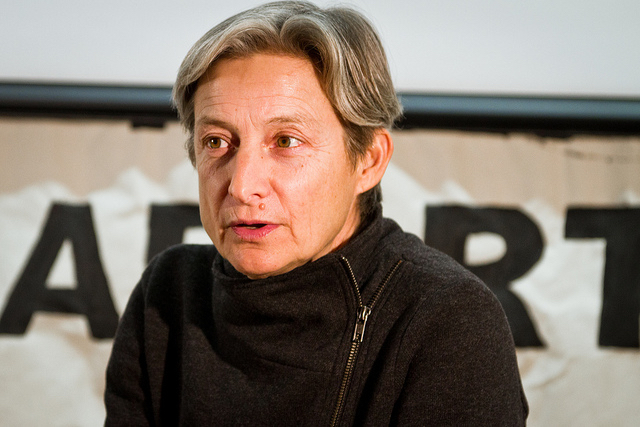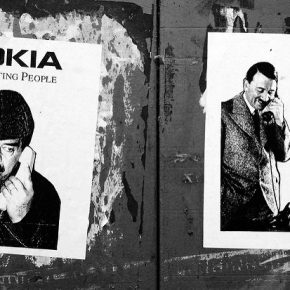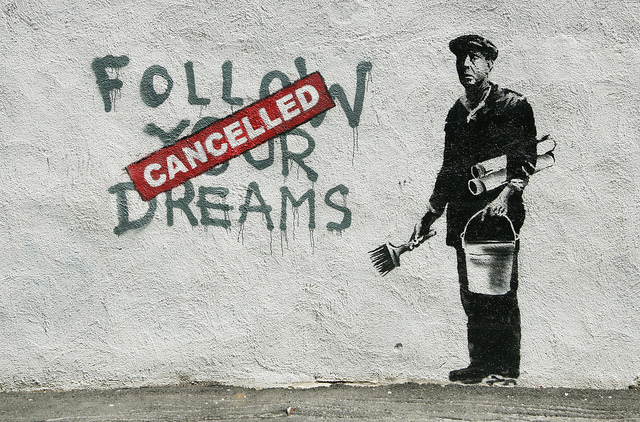I enjoyed Molly Fischer’s recent piece about Judith Butler for New York magazine, but I think it misses something significant about her ongoing relevance. Fischer concludes by suggesting that discourse about gender has moved beyond the performative theories Butler expounded in Gender Trouble. But Butler still remains wildly relevant on college campuses, particularly for undergraduates.
Fischer gives the impression that Butler has triumphed, but also that she has been surpassed. In this regard, popularity can seem like a drawback. “Today, it is possible to go online and read Judith Butler’s theory of gender performativity as explained with cats. There are Facebook pages like ‘Judith Butler Is My Homegirl.’ Quotes from Gender Trouble are reliably reblogged on Tumblr.” These examples testify to her influence, to be sure, but also the degree to which it has become more shallow as it has spread.
For those who are on the cutting edge of contemporary gender issues, such as university students, simplified and sometimes distorted distillations of Gender Trouble amplify the sense, as Maria Trumpler, director of Yale’s Office of LGBTQ Resources and a Professor of Women’s, Gender and Sexuality Studies, puts it, that the book is “really old-fashioned.” The Yale campus is very different from the days when Butler was an undergraduate there. The last four years in particular have seen an enormous growth in identities “beyond the binary,” Trumpler says, such as agender, bigender and genderqueer
Fair enough. But Butler’s work remains central to life on university campuses for a different reason. Nathan Heller’s recent piece for the New Yorker and other reports about campus protests makes it clear that it’s her work on speech, as in Excitable Speech, and assembly, as in her recent book Notes Toward a Performative Theory of Assembly that most pertain to university life right now. Indeed, I would argue that, from a present-day perspective, Butler’s work as a theorist of gender now looks like a special case of her broader work as a theorist of speech. It is difficult for me to read accounts of students calling the speech they hear on campus “violence” without thinking of Butler’s work after Gender Trouble.
A passage from the introduction to Excitable Speech underscores the point. Butler writes that “understanding performativity as a renewable action without clear origin or end suggests that speech is finally constrained neither by its specific speaker not its originating context” so that what someone intended to say has little bearing on where and how it gets heard. Performative speech is both “defined by social context” and “marked by its capacity to break with context.” So, counterintuitively, speech is “enabled precisely by the context from which it breaks.” What Butler is saying is that we normally think of taking speech “out of context” as a dirty trick, but we can only ever discover a speech act’s performative value — whether it does or does not inflict harm — once it is examined apart from its original context.
In the heterogeneous spaces of a university campus, where the same person might speak very differently to different groups at different time, the potential for performativity to complicate the distribution and reception of speech is huge. And it also threatens to undo every rhetorical position grounded on a simple us-versus-them opposition: “This ambivalent structure at the heart of performativity implies that, within political discourse, the very terms of resistance and insurgency are spawned in part by the powers they oppose.”
In other words, Butler is saying that when you “resist” dominant social forces by construing their hate speech (like racial slurs) as violence, you are actually participating in validating a model of language that can work against you as well. She uses the example of arguments about pornography, but we could just as easily look at arguments against gay marriage. We may scoff at a straight, married couple who says their religious rights are being infringed upon when two people of the same gender get married. But what they’re saying is that the political act that legitimizes gay marriages changes the terms of the institution of marriage without their consent, and, as a consequence, does injury to them in the same way that a slur or hate speech does injury.
Performativity has no political allegiances, though it is often thought of as a tool of insurgent political analysis. I think this is the push-pull we see on campuses now, with some campus activists calling for protections from what they see as hate speech and others saying that such protections constitute a restriction on free speech, and thus a form of injury. Butler has spent a long time describing and theorizing this sort of structure, where, as she puts it, “language constitutes the subject in part through foreclosure, a kind of unofficial censorship or primary restriction in speech that constitutes the possibility of agency in speech.” In other words, what we think of as a freedom of speech, with all of the privileges of expression that implies, is only enabled by a tacit agreement not to speak about certain things or in certain ways.
Right now the nature of those certain things and certain ways is becoming more and more uncertain. The limits of speech are being tested on both the left and right. They are tested on the left by campus activism that demands institutional protection from forms of speech they consider to be violence. They seek the power to punish people for certain kinds of hurtful language. Though Butler’s writings do not endorse those sorts of punitive measures – at least that I can see, I’m not a Butler expert – it seems clear to me that the dissemination of her ideas has influenced these activists.
From the right, those same forms of hurtful speech are becoming part of the political lingua franca. Utterances that would otherwise be called hate speech are drawn into a zone of acceptance that protects them from any plausible claim that they constitute a form of violence. Butler’s ideas, far from approaching comfortable retirement, need to be engaged now more than ever.
Photograph courtesy of Andrew Rusk. An earlier version of this essay appeared on Mark Sussman’s blog.





